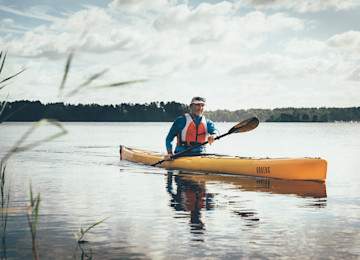
Which paddle should I choose?
Choosing a paddle for your kayak can feel tricky – there are many paddles to choose from, in all possible variations, colors, lengths and blade sizes. In this guide, we clarify some concepts to simplify your choice. Since there will be many paddle strokes on a kayak trip, it may be a good idea to spend a little extra time choosing a paddle that you enjoy and that suits you.
What to consider when choosing a paddle
- A 220 cm long paddle usually suits most people, plus/minus 10 cm
- Split paddles are easier both to store and transport
- A lighter paddle is more comfortable to paddle with, but is generally more expensive
The length of the paddle
The length of paddle you should choose depends on how tall you are, your experience and how wide your kayak is. A simple trick to get an idea of how long a paddle to choose is to stretch your arm straight up and measure from the ground to your fingertips – then you'll get an approximate length of which paddle you should buy. In general, a paddle length of 220 cm usually suits most people, plus/minus 10 cm.
If you have a wide single-person kayak, folding kayak or double kayak, you may need a longer paddle, as well as if you are tall. More and more paddles are extendable, which is convenient because you can adjust the length – you can make it short when upwind and long when downwind for instance.
Split or whole paddle?
Many paddles are available as either whole or divisible. The divisible ones are usually divisible into two parts with the split in the middle, but there are also three-part and four-part paddles. For the sake of paddling itself, there is no major difference between a whole or a divisible paddle. The big advantage of a divisible paddle is that it is much easier to transport and store – it is easier to shove in the shelf at home, in the car or if it is to be transported on/in the kayak. The downside to divisible paddles is that they weigh a bit more than non-divisible paddles.

The properties of kayak paddles
Materials
Paddles are made in all sorts of materials, but the most common are plastic, carbon fiber and fiberglass. Fully molded plastic blades are relatively easily cast in a mold and provide affordable and durable paddles that last a longer, however they tend to be a little heavier. Paddles in fiberglass or carbon fiber can be made thinner and thus become lighter, but are generally more expensive.
Weight
A few hundred grams here or there doesn't really matter, does it? It does, you lift the paddle many times during a kayak trip, so of course the weight comes into play. A lighter paddle is always preferable – it gives more speed and reduces the strain on your body. But lightweight paddles are usually more fragile and generally cost more.
Shape
A narrow paddle blade is more elongated in shape and a wide or tall one is shorter and thicker. Simply put, a paddle with a wide blade is used for higher paddle movements and is better suited for stronger people. A wide blade is therefore usually better suited for maneuvering and powerful paddling. Narrow blades generally suit most people, at least to begin with. A narrow paddle blade is gentler on the body and moves a little smoother in the water.
Enjoy your kayak adventure!